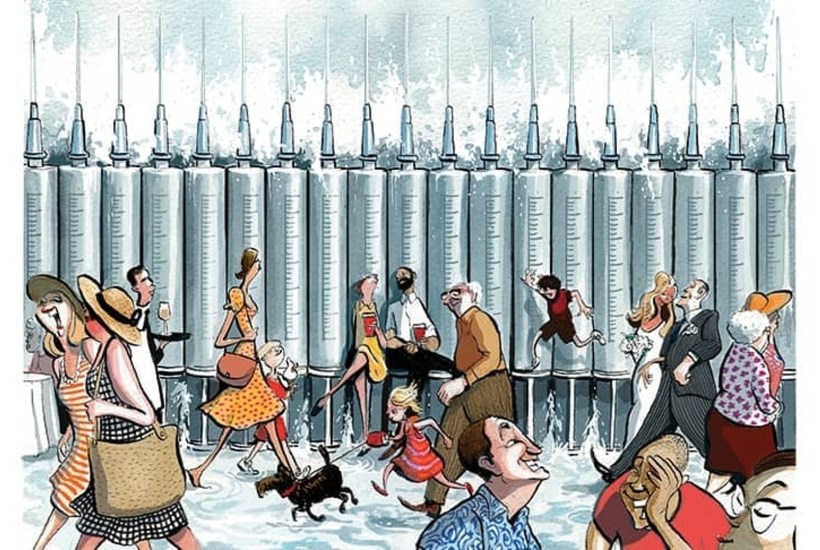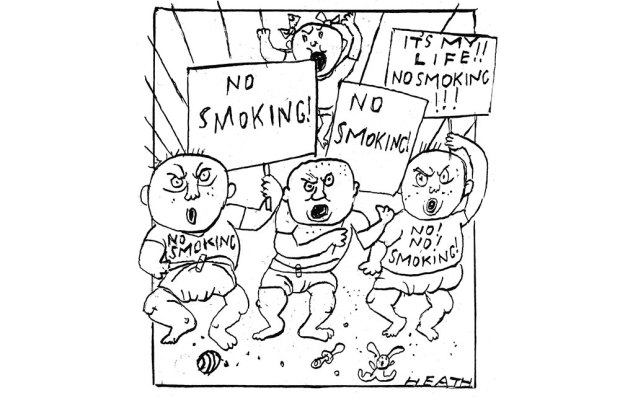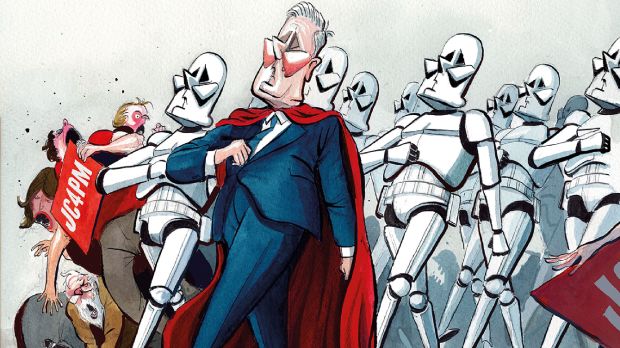Barely six weeks after it was first discovered in Britain, the Omicron variant has changed everything. Cases have soared far beyond records made in the first wave. Hospital admissions are surging and pupils are once again wearing masks in school. Modellers have produced terrifying figures — up to 25,000 hospitalisations a day, more than five times the last peak. It looks like a Covid groundhog day, a doom loop we seem unable to escape.
Last summer, just before the end of lockdown, I wrote in this magazine about a ‘third wave’ of infections which could be just as big as the first. But my model also pointed to something else: that we could ride out this wave without the health service being overwhelmed and without the need for further restrictions.
I have run the figures once again, and the findings are significant. The Omicron variant is more contagious than any variant we have seen; an estimated two million were infected at the last count. This may rise to three million. My model shows that this could peak any day now, with the vast majority of infections in the same category as your average winter bug: that is to say, mild with no clinical implications. The hospitalisation rate will be about a third of what it was under the Delta variant. The NHS will be able to cope.
There is a saying in my line of work: all models are wrong, but some can be useful. Models can certainly be judged by past results. In July, a few days after I wrote about the third wave, Sage scenario papers were published saying that we would see ‘at least’ 1,000 daily admissions — the numbers went to 7,000. My model forecast a peak of 908 daily hospitalisations on 20 August. The actual peak was 900, on 8 September.
This time around, Sage modellers are again producing headline-grabbing figures, warning of up to 6,000 deaths a day in the coming weeks. Yet again, the Sage scenarios are blood-curdling. And yet again, my model predicts something rather different.
I call it the Predictor Corrector Coronavirus Filter (PCCF), a model developed at Bristol University. So far, it has had a respectable record in both tracking the epidemic and predicting its future course. For predictions, I use a look-ahead version (the LA-PCCF), which envisages an ongoing mixture of Omicron and Delta infections. This matters because even if Omicron is far milder, this does not stop the risk of catching — or being hospitalised — by Delta.
My assumption is that population resistance to getting infected with the Omicron variant is only 60 per cent when compared with Delta. The highly successful booster campaign which will likely lift resistance to 90 per cent by the time you read this article. Boosters have been shown to reduce the risk of hospitalisation by 88 per cent. Ninety–four per cent of the over-sixties have been boosted. Given that this age group has accounted for 92 per cent of Covid deaths so far, this amounts to some pretty serious protection.
With such assumptions built in, my model suggests that total active infections will rise from two million to a peak of about 3.5 million: three times higher than the last peak (1.1 million cases). I then calculate that Omicron cases fall quite fast, a drop induced by a growing shortage of susceptible people left to infect. This is the result of the boosters.
But this could change. A delay of just three weeks in the effectiveness of the booster campaign could, according to my model, cause active infections to peak at more than 5.5 million. Hospitalisations per day would increase in roughly the same proportion. So the government is quite right to focus on boosters as a matter of national urgency: they are more effective than any lockdown restrictions.
In my model the daily hospital admission curve looks almost as steep as it did in January last year, peaking at just under 4,000. At the time of writing, admissions are around 2,000 a day. My main assumption here is that Omicron hospitalises at a third the rate for Delta: this is at the optimistic end of the UK Health Security Agency’s estimate of Omicron being between 50 per cent to 70 per cent less likely to hospitalise.
Today, however, there’s a big difference. Twelve months ago, society was heavily disrupted. Socialising, even outdoors, was banned; police were going after women who met in the park for a coffee. Schools were closed and much more besides. Non-Covid NHS treatment took quite a hit. This time, the PCCF envisages the NHS being busy (as it is every winter) but able to withstand the pressure. Given the social and economic costs of lockdown, the overall picture now marks a significant improvement on how the virus was handled in England last year.
Hospital admissions, however, are less important than occupancy — and there could be more good news on that front. A study published in the Lancet on South Africa’s experience showed that the average patient stay halved to just four days, compared with eight for Delta. This could have a transformative effect on the NHS’s ability to cope. Sage has conceded that: ‘If the average length of stay with Omicron were to be, for example, half as long as with Delta on average, then for a given level of hospital admissions, occupancy would be approximately halved.’ So the NHS should be put under less strain than last year even if the full effect of the booster campaign does not feed through until the end of January.
Finally, deaths. They have been low recently, around 100 a day, but they can occur up to three to four weeks after infection, so we would not expect to see much of an Omicron effect yet. The look-ahead PCCF model suggests a peak of 500 deaths per day in the middle of January, of which 400 will be down to Omicron. While every such death represents an individual and family tragedy, the number is less than half what was seen in England a year ago. This modelling is based on the case fatality rate in hospitals staying where it was with Delta (although there is growing evidence from South Africa that it might turn out to be lower).
In total, my model envisages about 8,500 Covid deaths this winter — a figure which has a significant error margin each way. But it ought to be put in the context of an average British winter where 20,000 to 35,000 die of flu and pneumonia.
If deaths peak at 500 a day, that will stand in comparison with the 1,200 a day of last year’s wave. And it’s also far fewer than what Sage envisaged in scenarios published on 18 December. It said then that even ‘Step 2’ Covid restrictions (no socialising outside of bubbles, outdoor-only service in restaurants and pubs) would limit deaths to a range of 500 to 3,000 a day. The only way of putting deaths into the 200 to 2,000 a day range, Sage said, was to ban household mixing and all socialising, bringing back stay-at-home orders seen in ‘Step 1’.
As things stand, my figure of 500 daily deaths is at the lower end of the range produced by Sage’s strictest lockdown scenario — but without any extra restrictions. For now, it seems that the government’s decision to adopt a wait-and-see approach has been vindicated.
There has been debate about whether Sage has been presenting predominantly worst-case scenarios to the government. The trouble with worst-case scenarios is that they will, by definition, usually be far too pessimistic (or, in other words, wrong). This makes them an unsafe basis on which to take decisions. Planning for the worst can only work if the precautions are relatively painless, which is clearly not the case with Covid restrictions. This is why my model has been constructed on a best-estimate basis.
The philosopher Sir Karl Popper wrote that all theories and models retain their usefulness only for as long as they continue to be validated and not ‘falsified’ by the data, and my model is no exception. But so far, incoming data has not falsified the model (although recent data may point to milder effects from Omicron). Covid is still horribly unpredictable, and there is no doubt the next few weeks will prove an anxious time for health service planners and NHS staff. But the message coming from my model is generally hopeful.
In recent months, we have occasionally heard people saying that we must learn to live with the virus. It could well be that, in resisting calls for lockdown this time, we already have.
Got something to add? Join the discussion and comment below.
Get 10 issues for just $10
Subscribe to The Spectator Australia today for the next 10 magazine issues, plus full online access, for just $10.
You might disagree with half of it, but you’ll enjoy reading all of it. Try your first month for free, then just $2 a week for the remainder of your first year.














Comments
Don't miss out
Join the conversation with other Spectator Australia readers. Subscribe to leave a comment.
SUBSCRIBEAlready a subscriber? Log in